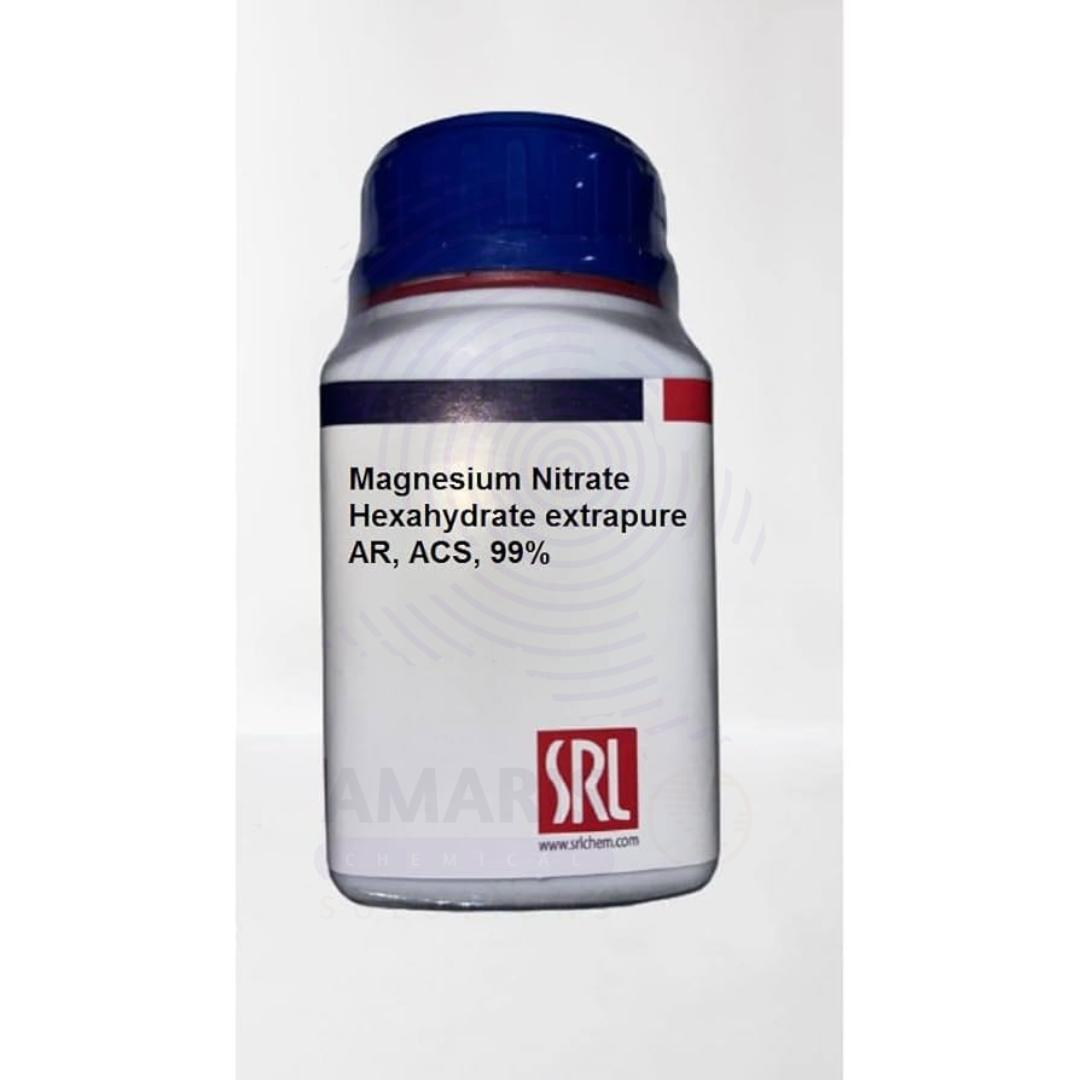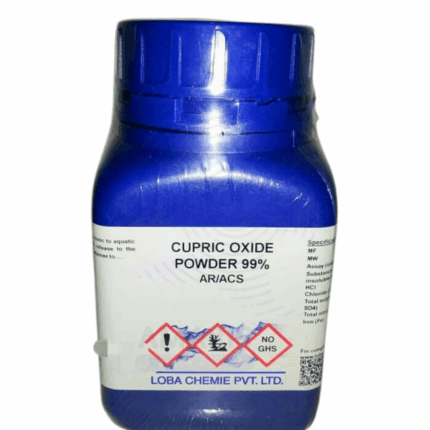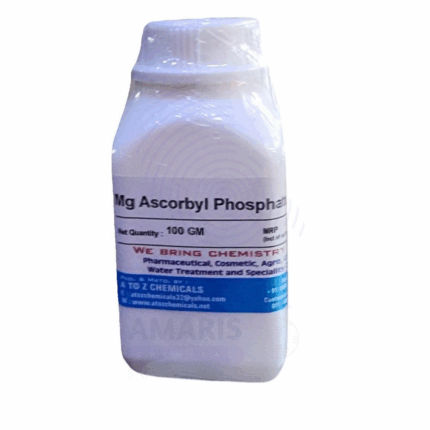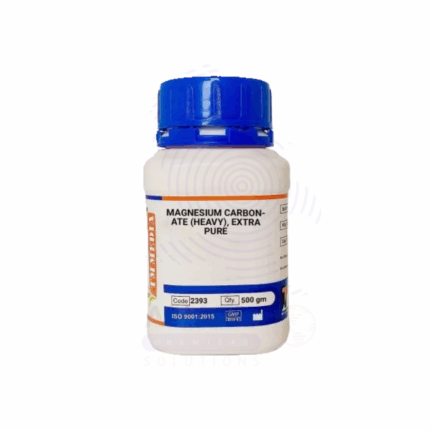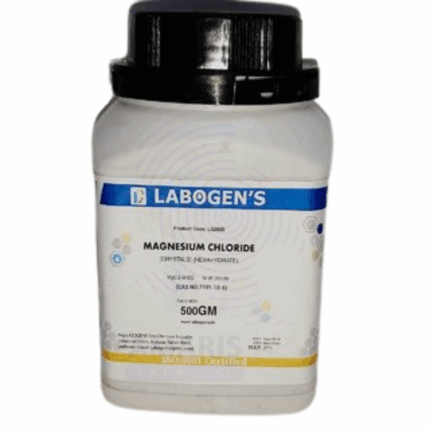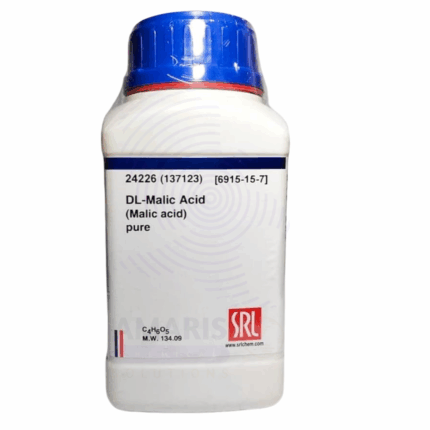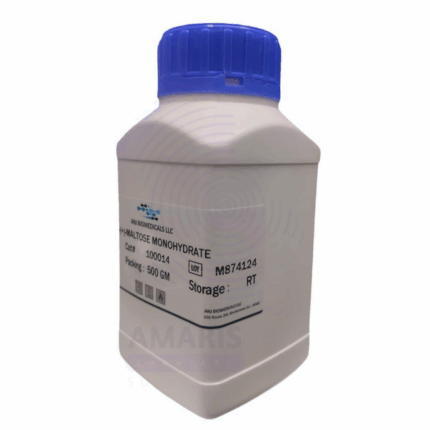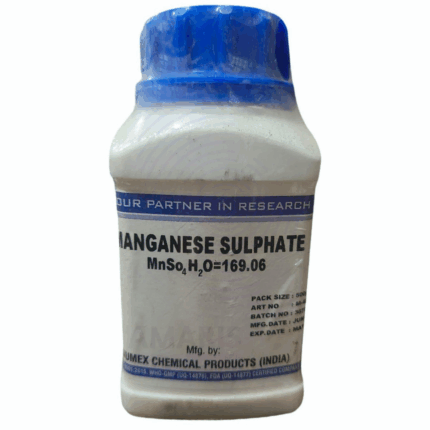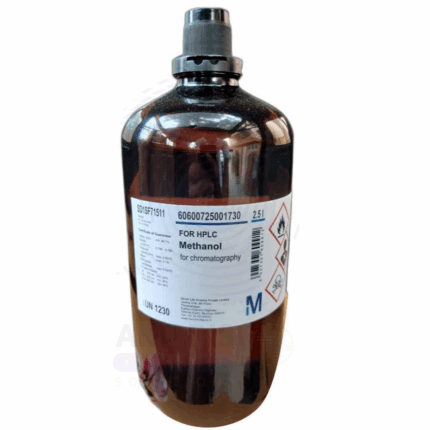
Magnesium Nitrate Hexahydrate Extra Pure
$ 19.10 Original price was: $ 19.10.$ 18.98Current price is: $ 18.98.
Magnesium Nitrate Hexahydrate Extra Pure is a crystalline compound known for its high solubility in water and exceptional purity, making it suitable for both laboratory and industrial applications. In analytical chemistry, it is commonly used as a reagent for preparing standard solutions and as a source of magnesium ions in various experimental procedures. Its oxidizing properties make it valuable in pyrotechnics and fertilizer formulations, where it provides essential nutrients for plant growth. This compound is also employed in ceramic production, textile treatments, and catalyst preparations, where a consistent, high-quality nitrate source is required. Its extra pure grade ensures minimal contamination, essential for high-precision work.
Magnesium Nitrate Hexahydrate Extra Pure
Primary Uses
- Source of Magnesium Ions:
- Used to supply Mg²⁺ ions in analytical chemistry and chemical synthesis experiments.
- Oxidizing Agent:
- Acts as a mild oxidizer in inorganic reaction studies or redox titrations.
- Dehydration Reactions:
- Useful in thermal decomposition experiments to study gas evolution and salt residue behavior.
Secondary Uses
- Catalyst Precursor:
- Used in the preparation of magnesium-based catalysts for organic synthesis or material science studies.
- Fertilizer Simulation:
- Employed in agricultural chemistry simulations to study nutrient uptake and soil chemistry.
- Standard Solution Preparation:
- Used in preparing standard magnesium solutions for calibration and titration in quantitative analysis.
| PACK SIZE |
500 grams Plastic Tin |
|---|
1. Basic Identification Attributes
- Chemical Name: Magnesium Nitrate Hexahydrate
- Synonyms: Nitromagnesite; Magnesium dinitrate hexahydrate
- CAS Number: 13446-18-9
- Molecular Formula: Mg(NO₃)₂·6H₂O
- Molecular Weight: 256.41 g/mol
- Appearance: Colorless to white crystalline solid
- Odor: Odorless
- Solubility: Very soluble in water and ethanol
- Grade: Extra Pure
2. Safety & Hazard Attributes
- GHS Classification:
- Oxidizing solid (Category 3)
- Eye irritation (Category 2A)
- Hazard Statements:
- H272: May intensify fire; oxidizer
- H319: Causes serious eye irritation
- Precautionary Statements:
- P210: Keep away from heat/sparks/open flames
- P220: Keep away from combustible materials
- P280: Wear eye protection/protective gloves
- P305+P351+P338: If in eyes, rinse cautiously with water for several minutes
- Personal Protective Equipment (PPE):
- Lab coat
- Safety goggles
- Nitrile gloves
- Avoid contact with combustible materials
- First Aid Measures:
- Inhalation: Move to fresh air; seek medical attention if discomfort occurs
- Skin Contact: Rinse with water and soap
- Eye Contact: Rinse thoroughly with water for at least 15 minutes; get medical attention
- Ingestion: Rinse mouth; do not induce vomiting; seek immediate medical help
- Fire Hazards:
- Not flammable, but supports combustion as a strong oxidizer
- Use water spray, foam, or CO₂; avoid dry chemical extinguishers
3. Storage & Handling Attributes
- Storage Conditions:
- Store in a cool, well-ventilated area
- Keep container tightly closed
- Store away from flammable or organic materials
- Protect from moisture and sources of heat
- Handling Tips:
- Handle under dry conditions
- Use non-sparking tools
- Minimize dust formation
4. Laboratory Applications
- Primary Uses:
- Oxidizing agent in analytical and preparative chemistry
- Source of nitrate ions in various laboratory synthesis reactions
- Catalyst precursor in material science research
- Secondary Uses:
- Fertilizer studies in controlled lab trials (as a nutrient source)
- Reagent in hygroscopic compound studies
- Standard for calibration in nitrate analysis
SAFETY PRECAUTIONS
Personal Protective Equipment (PPE):
- Wear a lab coat, nitrile gloves, and chemical splash goggles.
- Use a dust mask or operate in a fume hood to prevent inhalation of fine particles.
Handling:
- Avoid contact with skin, eyes, and clothing.
- Prevent generation of dust; avoid inhaling vapors or mists.
- Wash hands thoroughly after handling.
Storage:
- Store in a cool, dry, and well-ventilated area.
- Keep the container tightly sealed and protected from moisture.
- Store away from organic materials, combustibles, and strong reducing agents.
FIRST AID MEASURES
Inhalation:
- Move to fresh air immediately.
- Seek medical attention if breathing difficulty or irritation occurs.
Skin Contact:
- Wash thoroughly with soap and water.
- Remove contaminated clothing.
- Get medical advice if irritation persists.
Eye Contact:
- Rinse cautiously with water for several minutes.
- Remove contact lenses if present and easy to do.
- Continue rinsing and seek medical attention if needed.
Ingestion:
- Rinse mouth with water.
- Do not induce vomiting.
- Seek immediate medical advice.
FIRE FIGHTING MEASURES
Flammability:
- Not flammable itself but acts as a strong oxidizer. May intensify fire.
Extinguishing Media:
- Use water spray, foam, or dry chemical.
- Do not use dry combustible materials near the chemical.
Hazardous Combustion Products:
- May release toxic nitrogen oxides and magnesium oxides when heated or decomposed.
Firefighter Protection:
- Use self-contained breathing apparatus (SCBA).
- Wear full protective firefighting gear.


 Preservatives(food)
Preservatives(food) Flavor Enhancers
Flavor Enhancers Acidulants
Acidulants Sweeteners
Sweeteners Antioxidants
Antioxidants Colorants(food)
Colorants(food) Nutraceutical Ingredients (food)
Nutraceutical Ingredients (food) Nutrient Supplements
Nutrient Supplements Emulsifiers
Emulsifiers
 Collectors
Collectors Dust Suppressants
Dust Suppressants Explosives and Blasting Agents
Explosives and Blasting Agents Flocculants and Coagulants
Flocculants and Coagulants Frothers
Frothers Leaching Agents
Leaching Agents pH Modifiers
pH Modifiers Precious Metal Extraction Agents
Precious Metal Extraction Agents
 Antioxidants(plastic)
Antioxidants(plastic) Colorants (Pigments, Dyes)
Colorants (Pigments, Dyes) Fillers and Reinforcements
Fillers and Reinforcements Flame Retardants
Flame Retardants Monomers
Monomers Plasticizers
Plasticizers Polymerization Initiators
Polymerization Initiators Stabilizers (UV, Heat)
Stabilizers (UV, Heat)
 Antifoaming Agents
Antifoaming Agents Chelating Agents
Chelating Agents Coagulants and Flocculants
Coagulants and Flocculants Corrosion Inhibitors
Corrosion Inhibitors Disinfectants and Biocides
Disinfectants and Biocides Oxidizing Agents
Oxidizing Agents pH Adjusters
pH Adjusters Scale Inhibitors( water)
Scale Inhibitors( water)
 Antioxidants(cosmetic)
Antioxidants(cosmetic) Emollients
Emollients Fragrances and Essential Oils
Fragrances and Essential Oils Humectants
Humectants Preservatives
Preservatives Surfactants(cosmetic)
Surfactants(cosmetic) Thickeners
Thickeners UV Filters
UV Filters
 Fertilizers
Fertilizers Soil Conditioners
Soil Conditioners Plant Growth Regulators
Plant Growth Regulators Animal Feed Additives
Animal Feed Additives Biostimulants
Biostimulants Pesticides (Herbicides, Insecticides, Fungicides)
Pesticides (Herbicides, Insecticides, Fungicides)
 Active Pharmaceutical Ingredients (APIs)
Active Pharmaceutical Ingredients (APIs) Excipients
Excipients Solvents(pharmaceutical)
Solvents(pharmaceutical) Antibiotics
Antibiotics Antiseptics and Disinfectants
Antiseptics and Disinfectants Vaccine Adjuvants
Vaccine Adjuvants Nutraceutical Ingredients (pharmaceutical)
Nutraceutical Ingredients (pharmaceutical) Analgesics & Antipyretics
Analgesics & Antipyretics
 Analytical Reagents
Analytical Reagents Solvents(lab)
Solvents(lab) Chromatography Chemicals
Chromatography Chemicals Spectroscopy Reagents
Spectroscopy Reagents microbiology-and-cell-culture-reagents
microbiology-and-cell-culture-reagents Molecular Biology Reagents
Molecular Biology Reagents Biochemical Reagents
Biochemical Reagents Inorganic and Organic Standards
Inorganic and Organic Standards Laboratory Safety Chemicals
Laboratory Safety Chemicals Specialty Laboratory Chemicals(Special Laboratory Equipment)
Specialty Laboratory Chemicals(Special Laboratory Equipment)
 Demulsifiers
Demulsifiers Hydraulic Fracturing Fluids
Hydraulic Fracturing Fluids Scale Inhibitors(oil)
Scale Inhibitors(oil) Surfactants(oil)
Surfactants(oil) Drilling Fluids
Drilling Fluids
 Dyes and Pigments
Dyes and Pigments Bleaching Agents
Bleaching Agents Softening Agents
Softening Agents Finishing Agents
Finishing Agents Antistatic Agents
Antistatic Agents
 Admixtures
Admixtures Waterproofing Agents
Waterproofing Agents Sealants and Adhesives
Sealants and Adhesives Curing Compounds
Curing Compounds Concrete Repair Chemicals
Concrete Repair Chemicals Anti-Corrosion Coatings
Anti-Corrosion Coatings
 Surfactants(cleaning)
Surfactants(cleaning) Builders
Builders Enzymes
Enzymes Solvents (Cleaning)
Solvents (Cleaning) Fragrances
Fragrances
 Electronic Chemicals
Electronic Chemicals Catalysts
Catalysts Lubricants
Lubricants Photographic Chemicals
Photographic Chemicals Refrigerants
Refrigerants Automotive chemicals
Automotive chemicals Pyrotechnic Chemicals
Pyrotechnic Chemicals
 Biodegradable Surfactants
Biodegradable Surfactants Bio-based Solvents
Bio-based Solvents Renewable Polymers
Renewable Polymers Carbon Capture Chemicals
Carbon Capture Chemicals Wastewater Treatment Chemicals
Wastewater Treatment Chemicals
 Pigments
Pigments Solvents(paint)
Solvents(paint) Specialty Coatings
Specialty Coatings Binders/Resins
Binders/Resins Additives
Additives Driers
Driers Anti-Corrosion Agents
Anti-Corrosion Agents Functional Coatings
Functional Coatings Application-Specific Coatings
Application-Specific Coatings
 Fresh Herbs
Fresh Herbs Ground Spices
Ground Spices Whole Spices
Whole Spices Spice Blends
Spice Blends Dried Herbs
Dried Herbs
 Leavening Agents
Leavening Agents Dough Conditioners
Dough Conditioners Flour Treatments
Flour Treatments Fat Replacers
Fat Replacers Decoratives
Decoratives Preservatives(baking)
Preservatives(baking)
 Plasticizers & Softeners
Plasticizers & Softeners Reinforcing Agents
Reinforcing Agents Adhesion Promoters
Adhesion Promoters Vulcanizing Agents
Vulcanizing Agents Antidegradants
Antidegradants Blowing Agents
Blowing Agents Fillers & Extenders
Fillers & Extenders Accelerators & Retarders
Accelerators & Retarders